Recent Posts
-
Yes, There IS a Future!
December 26, 2025
-
Real Crimes and the Coming Violence
September 6, 2025
-
Whither Modern Life?
June 27, 2025
-
What the Hell
June 18, 2025
-
As Darkness Engulfs Us
April 6, 2025
-
AI, Risk, and Work
January 17, 2025
-
“Things Are in the Saddle, and Ride Mankind”
December 29, 2024
-
Forgotten Futures in Seattle
December 12, 2024
-
Autocracy Defeats Neoliberalism
November 14, 2024
-
History… We’re Soaking in It!
October 2, 2024
|
Part 1: intro to TED, my speech at the conference
Part 2: Highlights of other TEDx Amazonia Talks, especially from Amazonians
Part 3: Critical look at the Entrepreneurially Minded TED speakers
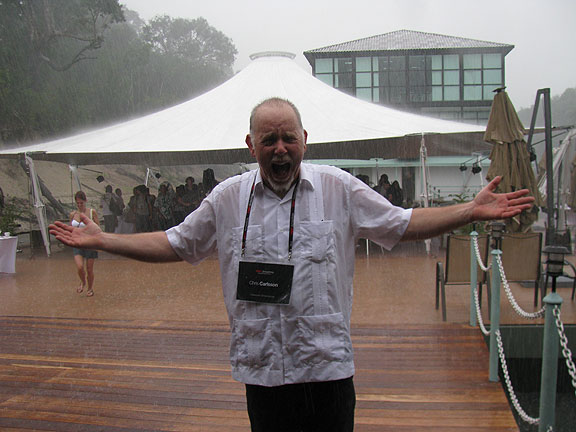 I was so happy when tropical rains began falling on us. Ironically, we had come to the most fecund place on earth, facing a world economy based on a logic” endless growth–that has generated one of the greatest species extinction pulses in the history of the planet. Could we explore new ways of working and living that could ensure a quality of life for all species, without addressing the elephant in the room, the economic system based on perpetual growth? Apparently that was the hope, since few of the participants took on that larger question (notably, the two economists Enrique Leff and Hugo Penteado, as well as yours truly, DID try to attack dysfunctional economic thought). Opposing capitalism and growth wasn’t the stated purpose of our gathering, to be sure. TED is an organization rooted in the quasi-libertarian high-tech boom that started with the personal computer and accelerated through the 1990s and 2000s, and as such, seems to be a self-selecting culture of a subsection of the global elite that favors entrepreneurialism as the answer for the world’s problems, including the topic of this gathering in the Amazon.
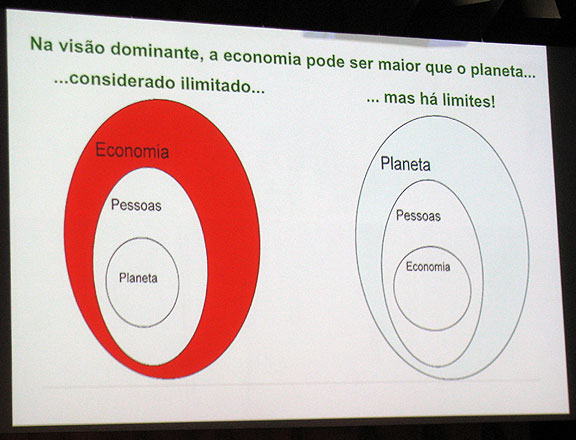 Hugo Penteado's chart put it to economics: what is dependent on what exactly? TED stands for Technology, Entertainment, and Design, and it’s a very specific brand that has been spreading itself globally with enormous success, especially during the past 8 years (it actually started back in the 1980s). The x after TEDx indicates that it is an independently organized event, licensing the format and reputation of the main TED organization, which is centered in the U.S. Former WIRED magazine publisher Chris Anderson took the helm of it in the early 2000s and absorbed it within his not-for-profit foundation. Their motto is “ideas worth spreading,” and you can find hundreds of their Talks online, free to watch, and many are indeed brilliant. That said, you won’t hear a lot anti-capitalist rhetoric or thinking at a TED conference. In general, they are fellow travellers of Stewart Brand and his early 1970s Whole Earth Catalog, followed by the new computer culture that accelerated in the 1980s after the emergence of the personal computer. Ideologically they share a belief that the gray bureaucracies of government and old-school corporate giants are the problem (on their website they advertise that the TED Talks are “untainted by corporate influence”), but the answer lies in independent entrepreneurialism rather than in any kind of social or collective action. Brilliant investors and inventors will continually produce technological breakthroughs that will solve the problems humanity and the planet face. (Fred Turner’s fantastic history of this is in “From Counterculture to Cyberculture: Steward Brand, the Whole Earth Network and the Rise of Digital Milleniallism”” highly recommended!)
This TEDx event drank deeply from this long-running river of self-congratulatory entrepreneurialism. Let’s face it, the past thirty years has been a long nightmare (for people like me) of triumphant business ideology, and the folks at WIRED magazine, the Long Now Foundation (Brand and Kevin Kelley’s thinktank) and other quasi-libertarian tech culture types have been an important wing of that, complementing the straight-forward glorification of wealth and greed as pushed by Reagan, Bush, Wall Street, et al.
I saved a grouping of TEDx speakers for my last entry. These contributors include some of the people I made great friends with, but also represent the cutting edge of modern capitalism, in terms of their use of games, business, participation, and crowd-sourcing. I’ve been saying for the past couple of years, “better is better than worse,” and many of the efforts described here are bettering things in their own ways. But I’m interested in the way they also begin a process of renovating capitalism, of advancing this crazy, exploitative system’s capacity to capture new activities, new ways of thinking, and channel them back into the typical forms of products and commodities, markets, wage-labor, and monetary relations.
Continue reading TEDx Amazonia: Entrepreneurialism, Innovation, and Survival, Part 3
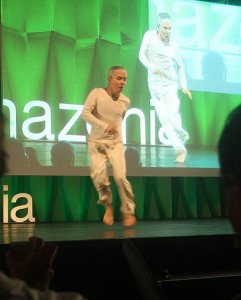 Antonio Nobrega opens the event with a beautiful performance.  Nelida Silva dances to open day two of the conference. Part 1: intro to TED, my speech at the conference
Part 2: Highlights of other TEDx Amazonia Talks, especially from Amazonians
Part 3: Critical look at the Entrepreneurially Minded TED speakers
Each day began with a beautiful dance, Saturday’s a wild modern piece by Brazilian dancer Antonio Nóbrega and Sunday’s a traditional village dance from the Peruvian highlands by Nelida Silva. A baroque orchestra serenaded us at the start of the sixth and final bloc on Sunday afternoon, while Saturday’s four blocs ended with Bahian musician Lucas Santtana, who never called himself an anthropophagist, but the way he cannibalized musics from the rich treasure of Brazil as well as elsewhere certainly made him one.
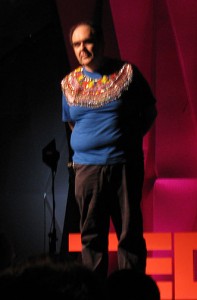 Andre Abujamra My favorite musical presenter was André Abujamra, a funny thoughtful musician who has made his name more outside of Brazil than inside, even though he’s played behind Tom Zé and other iconic stars. He gave me a copy of his latest CD called “Mafaro” and it’s fantastic! He came up wearing a shoulder-covering sequined garment and waited for his cue that didn’t come. He finally said “fuck it” and launched into his bit a capella. The slides played and eventually the music came on too. It was a charming, funny piece. The very last speaker at the end was the American “Sound Chaser” Gordon Hempton who played bird songs from all over, including a one-minute trip around a 24-hour soundscape of the world’s natural areas. He’s a big noise pollution activist too, much to my happiness, and helped shift our thinking by calling the Earth a huge solar-powered jukebox. He even used maps to show how the more sun falls on an area, the louder it is in terms of birds and bugs.
It wasn’t all lecture, but a lot of it was. I went early, number six in the first bloc (the event was divided into six blocs of 8-10 presenters each, four blocs on Saturday from 10 a.m to 10:30 pm with 15-20 minute breaks as well as lunch and dinner, and two blocs on Sunday, ending much later than planned, around 4:30). I was given 10 minutes, which was the average length, though some folks got 15-18 minutes and others only 5-8 minutes. And we were expected to stick to it, though a lot of people, especially the Amazonians who spoke, took all the time they wanted and went way over their allocations (I only blew my limit by about 90 seconds).
Continue reading TEDx Amazonia: Culture, Ecology, Amazonia, Part 2
Part 1: intro to TED, my speech at the conference
Part 2: Highlights of other TEDx Amazonia Talks, especially from Amazonians
Part 3: Critical look at the Entrepreneurially Minded TED speakers
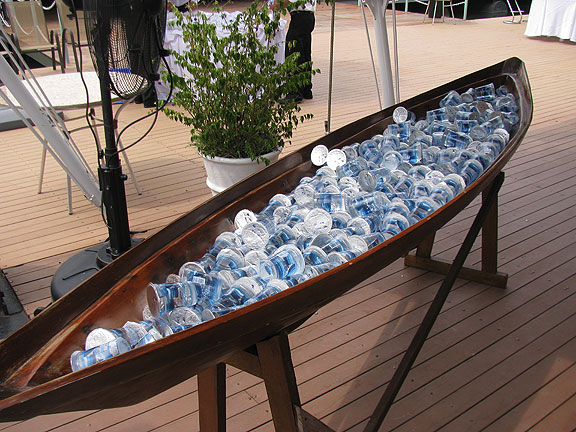
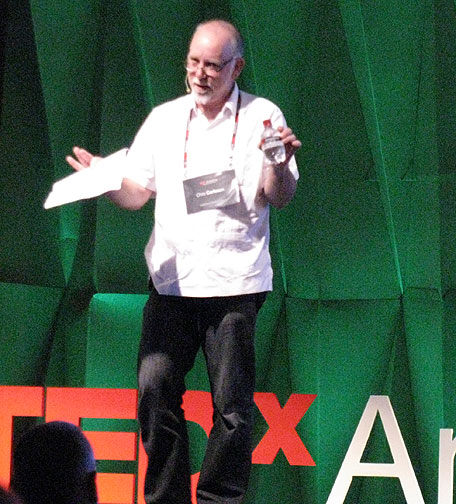 I was so annoyed that I improvised an opening lament/complaint about it when I gave my Talk in the first of six blocs over two days. The audience cheered in support. It’s quite difficult to summarize the just-completed TEDx Amazonia. Brazilian organizers (mostly from Sao Paulo themselves) staged the event Nov. 6-7 at the Amazon Jungle Palace Hotel which sits about 45 minutes up the Rio Negro River from Manaus in the heart of the forest (the enormous expense of flying in all the speakers and fancy hi-tech equipment was covered by corporate sponsors Santander Bank and a variety of Brazilian media and marketing companies). Normally it’s a floating hotel that can be reached directly by river ferries of all types. Here’s a photo of the place when the waters are running high (this was also taken before the conference center and dining hall we used were added).
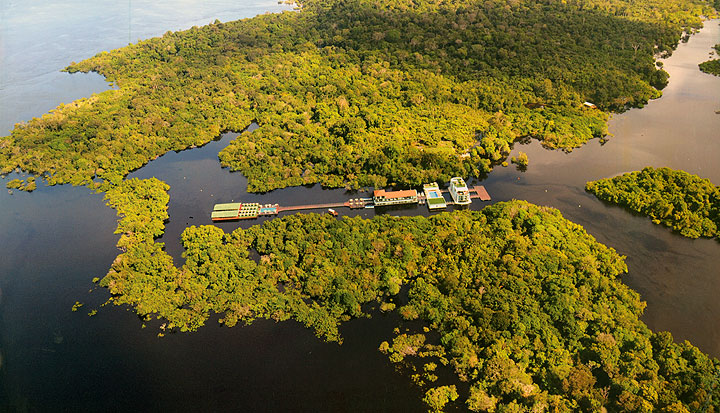 Amazon Jungle Palace Hotel prior to some of its recent additions, and long before the drought left it aground in the forest. But we had quite a different experience, as detailed in my previous post. We were on what felt like an ocean liner that had run aground in a lost corner of the jungle, and was slowly disappearing into the sun-baked mud as the river evaporated around it. By the time we left the rains had started again, but it wasn’t clear how long it would before this historic drought would end.
So having a gathering of 50 speakers and 250 hand-picked audience members in the heart of the jungle to address the official theme of “Quality of Life for All Species” took on a different hue once we were here, facing the impressive and unanticipated (for me at least) drought. My first stab at dividing up the presenters into thematic clusters or types produced this list: artists (including musicians and dancers), game makers, scientists (biologists, a chemist, a couple of permaculturists), residents of the Amazon involved in local business and ecological activism, and economists (which for lack of a better place, I’d put myself too), and some straight-up business people representing their companies. At least 60% of the speakers were Brazilian, but we were also from the U.S., Finland, Peru, Mexico, England, Ecuador, Colombia, and the audience made it broader still.
Continue reading TEDx Amazonia: Quality of Life for All Species, Part 1
|
Hidden San Francisco 2nd EDITION!

NEW 2nd EDITION NOW AVAILABLE!
Buy one here
(Pluto Press, Spring 2025)
|



















